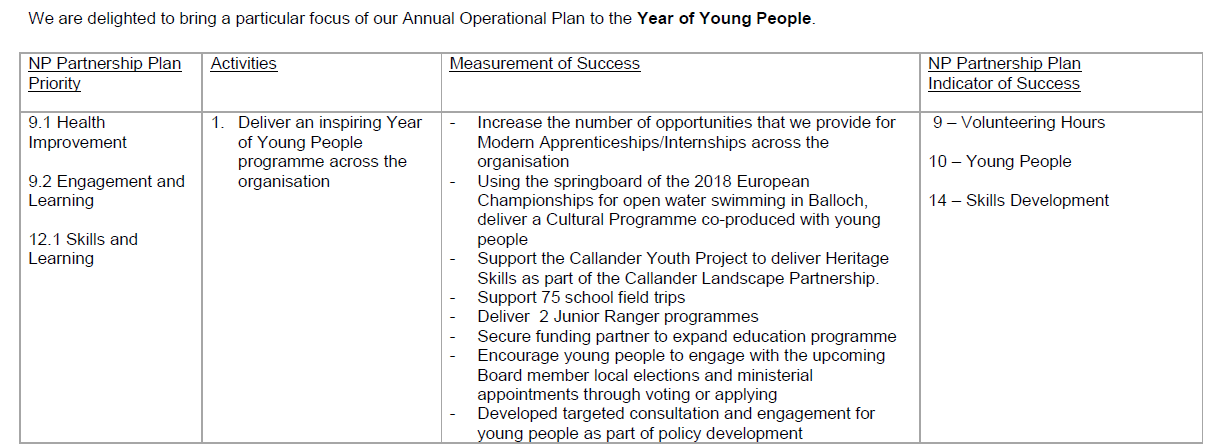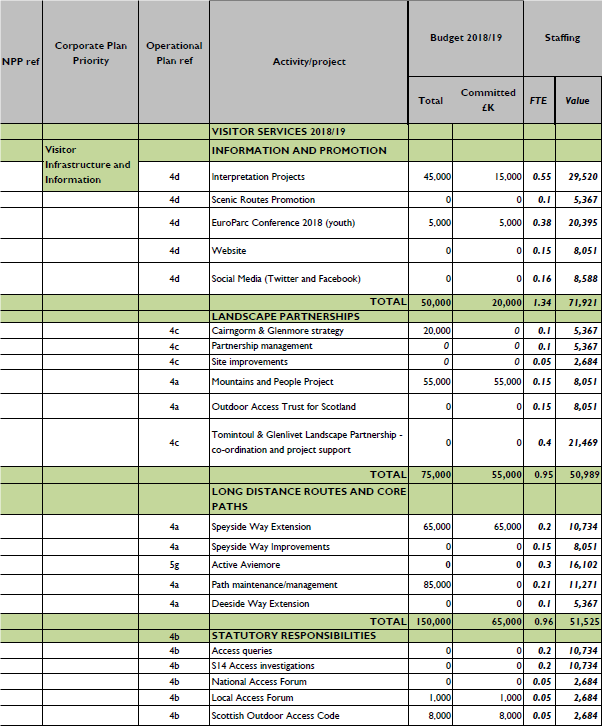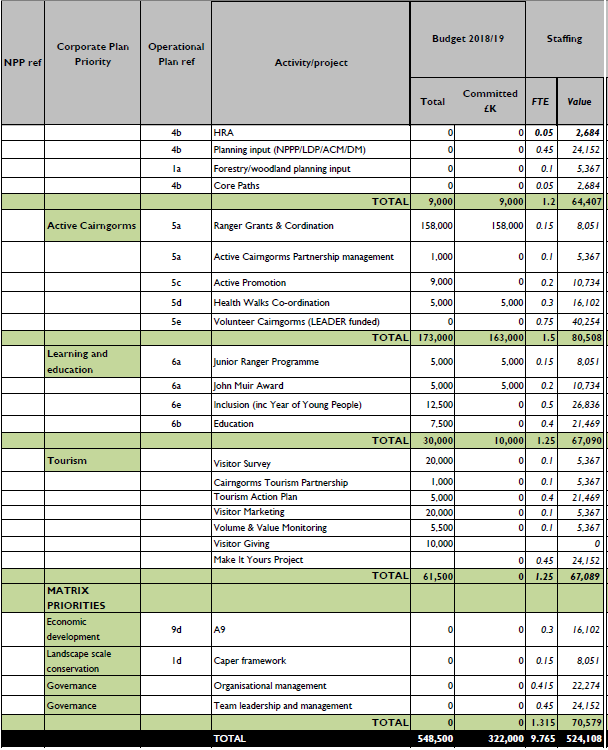
The Loch Lomond and Trossachs National Park Authority Board Meeting on Monday morning was a laughable experience (see here for all papers). The camping byelaws now dominate almost everything the National Park does, even if LLTNPA Board members don’t appear to appreciate this, to the exclusion of what it should be doing. The laughs came from the yawning gap between what was said, whether written in the papers or expressed at the meeting, and reality.
The political agenda
Gordon Watson, the LLTNPA Chief Executive, who with his mentor, the previous convener, Linda McKay, bears most responsibility for the byelaw disaster reported that the Minister had approved the National Park Partnership Plan, which is supposed to govern what the Park will do over the next five years but is devoid of meaningful content (see here), and
“In the same letter the Cabinet Secretary acknowledges receipt of the Annual Update Report on the Loch Lomond and The Trossachs Camping Byelaws 2017 and congratulates the National Park Authority on its hard work in implementing them.”
The Update Report was thoroughly flawed (see here), failing to include factual data some which it has since been forced to provide under FOI and undermines its conclusion, but the Minister, Roseanna Cunningham, was right that the LLTNPA had had to work very hard to implement the byelaws – far harder than ever envisaged. What she doesn’t seem to appreciate yet is how the byelaws have been distorting the work of the National Park – instead of congratulating the LLTNPA, she should have been demanding a cost-benefit analysis.
The year of young people and camping

The LLTNPA, always keen to be seen to be promoting the Scottish Government’s agenda, has made “Delivering an engaging and inspiring programme to support the Year of Young People” one of its five priorities for its 2018-19 Operational Plan. Keen to pursue another planning quality award for the LLTNPA (there is a category for involving Young People this year), although unaware that most young people cannot afford to live in the National Park, Petra Biberbach, chair of the Planning Committee asked staff about the budget available to support this work. It turned out there is basically no budget, which casts doubt on what the plan meant when it says it will support 75 – a paltry figure anyway – school field trips this year. A phone call from a Ranger to a hard pressed teacher leaving it up to them? What you can be pretty certain of is there will be no financial support to help children from poorer areas in the Glasgow conurbation to visit the National Park

Plans without a budget are hot air or pure spin. If this budget is split equally that would be a grand total of £13k to support the Year of Young People programme. If.
Young People, of course, are being portrayed as the lost generation in the media, lost because are more exploited and have less money. Consequently they are less likely either to get out to the National Park in the first place or to be able to afford to pay for accommodation once they are there. Its not that Young People don’t want to get out, its they can’t afford to unless they have parents who can afford to pay, and this is reflected in who backpacks the West Highland Way. The east Loch Lomond byelaws impacted disprortionately on young people and, if the LLTNPA ever provides a proper breakdown of 828 warnings issued for breach of the byelaws last year, I suspect young people will be disproportionately represented. In other words there is a good case that the camping byelaws are helping to make the National Park a young people free zone – some young person could maybe ask the Children’s Commissioner to investigate?
Instead of a proper social analysis of what need to be done to help young people work, live in or enjoy the National Park, there is spin and unfortunately there appears to be not a single Board Member capable of cutting through this.
The impact of the camping byelaws on the Ranger Service
A similar failure to discuss what is really go on took place in a discussion on the LLTNPA’s voluntary Ranger Service. Lindsay Morrison, chair of the Audit Committee, noted 6000 hours had been provided by voluntary rangers last year – it sounds a lot but Park paid staff work about 1500 hours each a year so this is four full time staff equivalents – and wanted to increase that number 10 times. Leave aside the question of whether this is remotely realistic in the current labour market, where people either work excess hours or have to be available to work on zero hour contracts, or desirable the response from Simon Jones, Director of Conservation, on this was quite clear. The full-time Ranger service does not have the capacity to support more volunteers. What he and no-one else said is that this is because the full-time Rangers are having to devote almost all their time to enforcing the byelaws:
After a very successful summer the Ranger Service undertook a thorough review of the season including; patrolling deployment, working systems resourcing & procedures. This has informed planning for the summer 2018 visitor management season including development of a revised deployment model, seasonal staffing structure & refining of work systems & procedures.
From January the key focus for the team will finalising plans & preparations for the start of the camping management byelaw period on the 1st March. Key milestones include; the recruitment of Seasonal Rangers, delivery of a revised training package for all staff, completion of preseason camping permit area inspections and preparation of all resources required for core service delivery. (para 6.12 Organisational Update Report).
The full time Rangers are now basically full-time enforcement officers who spent the period after the byelaw season evaluating it and then the period before this season preparing for it. Even so, the papers showed this was NOT enough and the LLTNPA has recruited:
an additional Seasonal Ranger Team Leader. This is a key role to manage and support the Rangers whilst on patrol and deploy them to where they are most needed.
The LLTNPA has converted, without discussion, its Ranger service into Enforcement Officers.
The LLTNPA’s budget for 2018 – what are they really spending on the camping byelaws?
What has happened to the Ranger Service is crucial to what the LLTNPA is able to achieve as a National Park and more specifically to provide infrastructure for all visitors. The Ranger service is the largest in Scotland and consumes a significant proportion of the LLTNPA’s budget. If its devoted to chasing campers, there is very little resource that can be used for anything else.

What LLTNPA senior staff now appear to be doing is covering up what they actually spend on the byelaws – a figure that needs to be in the open so there can be a proper cost benefit analysis. Apart from this capital expenditure and the full-time Ranger, there are many other staff who appear very little else than work on the byelaws: this includes the Visitor Management Team, the Visitor Experience Team, the Communications Team and the Governance Team. Because the LLTNPA in their breakdown of budget costs treat all staff salaries as one line, its impossible to even to come up with an estimate of the total spent on the byelaws but I would hazard a guess that last year it accounted for over half the total expenditure of the National Park Authority.
The job of the LLTNPA Board should be to ensure there is absolute transparency on this – you’ve guessed, not a question was asked. The question should have been asked though because its not just the Year of Young People which has been awarded paltry sums but all the LLTNPA’s nature conservation activities. Look at the budget extract above, a grand total of £52k is being spent on Nature Conservation. Its no wonder the LLTNPA is not achieving anything!
Its worth contrasting the way LLTNPA budgets are presented with those of the Cairngorms National Park Authority, which has a significantly smaller total budget allocated, and which meets tomorrow:

Note how where the CNPA has no budget to allocated to a project, it still allocates staff time showing how staff are used across the organisation. If the LLTNPA took a similar approach it would show just how distorted its work has become, justification for why it is better described as a Camping Management Authority than a National Park.

Note too the relatively small amount that the CNPA spends on Rangers and that under Learning and Education it has clearly allocated money to the Year of Young People. YOU may not agree with the CNPA’s allocation of resources, but it provides transparent information which will allow its Board to have an informed debate tomorrow and for the public to make informed criticism. In budgetary and transparency terms the CNPA is ahead of the LLTNPA by miles.
An audit into the byelaws
The LLTNPA though appears to have been trying to cover its back as far as its failures were concerned. The Audit Committee reported that West Dunbartonshire Council had done an internal audit into how the byelaws had been implemented. I have checked Audit Committee papers subsequently and this internal audit was not on the original audit plan agreed for last year but added to the programme in June, along with Fixed Penalty Notices. At some stage, before the audit was carried out, Fixed Penalty Notices got dropped – presumably because as FOI responses show the Park has failed to take any action against litterers who were not campers so there was nothing to audit.
While the two recommendations of the Audit Report were in the papers to the Board, there was no discussion of the Audit Report (see here) at the meeting so I looked it up afterwards. The first recommendation in effect pointed out that the Camping Management Zone signs agreed by the Board were totally useless because no-one knows what a camping management zone is. The Park’s response is to waste yet more money (hardly anyone whizzing by in their cars notices these signs anyway) changing the signs:
The large road threshold signs are scheduled to be revised to make the messaging clearer with the inclusion of the dates that the Camping Management Byelaws operate within and additional text to clarify that camping within the Camping Management Zones is permissible by permit only.
The other main concern from the audit was that only one person at present can refer campers to the Procurator Fiscal and this could lead to delays in campers being criminalised. Expect more prosecutions this year!
What the audit report didn’t do was look at the costs of implementing the byelaws and how this has impacted on the work the National Park should be doing. Instead it highlighted some areas of good practice including:
The first annual update report has been submitted to the Scottish Ministers on the implementations of the Camping Management Byelaws 2017 on its first year of operation from March to September 2017; Comment; doing what you are required to do by Ministers is hardly good practice and the Audit Report completely failed to consider if the Update Report to Ministers contained all the information available to LLTNPA staff at the time (it didn’t!).
There is a number of policy and procedures documents in place indicating effective governance; Comment: leaving aside some of this documentation is public, an audit is supposed to look at whether a procedure is being followed, not just that it exists.
Extensive training is provided to Rangers; Comment: I asked for a copy of the written materials used for training under FOI and have been told none exist. Some training!
I don’t blame the auditors from West Dunbartonshire Council for this, this whole audit has been set up.
Where next?
The LLTNPA is clearly trying to make the camping byelaws business as usual and at the same time some of the Board and staff are hoping that people may start to accept them so they could redeploy some of the resources being deployed at present to other things:
As a result of the communications work and media coverage, awareness of the Camping Management Byelaws should be greater. Weather depending, this combined with the positive feedback received from those who camped last year, may lead to an increase in campsite and permit area use in the 2018 season.
While its possible with the threat of prosecuting hanging over them more regular campers might start buying permits or go elsewhere, the byelaws are so incomprehensible, unfair and out of tune with access rights that I think they will continue to cause the LLTNPA mighty problems. What the Board Meeting showed is that older Board Members still have their head in the sand while newer ones don’t know enough to question what is going on.
Parkswatch will continue to expose what is really going on at regular points through the year but until this becomes a political issue, and political pressure is put on Ministers, I am afraid the shambles will continue.

When is the Scottish Government going to get a grip on this shambles? Why does it approve a massive allocation of public money to the Loch Lomond and Trossachs National Park to employ rangers to spend most of their time chasing and threatening campers with prosecution? Meanwhile, the Cairngorms National Park employs no rangers and has no need for camping byelaws. Last night, Simon Jones, a senior official at the Loch Lomond Park, admitted on BBC 1, in an interview with David Hayman, that they were engaged in a “battle” to deal with camping issues (“The battle for Scotland’s countryside”, BBC iplayer). This extraordinary explanation was supposed to justify the camping byelaws. Surely it is now time for the Scottish Government call a halt to this nonsense? Perhaps it should reduce the budget for the ranger service in the Loch Lomond Park and spend it instead on camping pitches, toilets and litter collection services in and around the bonnie banks? Or would it be better to transfer the money eastwards to the Cairngorms to provide a real ranger service? This is what we need, not a gang of quasi security and enforcement officers engaged in “battle” with innocent campers in the wild west.